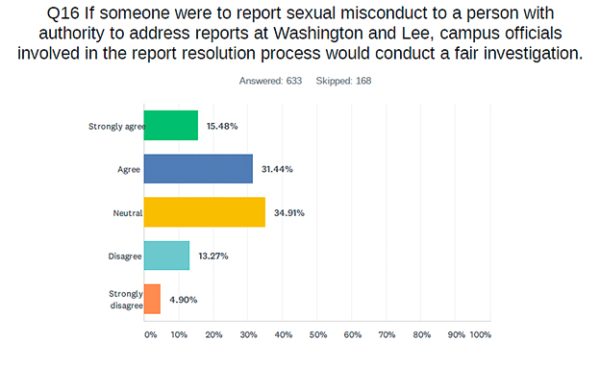Local landlords explain why rent is higher for W&L students
Landlords say increased maintenance and repairs, addressing noise complaints from neighbors account for upped student housing costs
November 7, 2016
A number of Lexington landlords say they charge Washington and Lee seniors and law students more to live in off-campus rental houses than they would otherwise charge local Rockbridge County residents for the same homes.
But according to Tim Welsh and Michael Stearns, who collectively own and rent 14 student houses in the Lexington area, the issue of pricing is far less black and white than many students may imagine.
The lessors said that the increased cost of and effort involved in maintaining student-run homes, fielding noise and party-related complaints from students’ neighbors and police officers, and cleaning and repairing these houses each summer are the driving forces behind their pricing decisions.
And with the advent of Upper Division Housing, land-lords will now be forced to refurbish the vast majority of their student homes every single year as new undergraduate lessees move in each August and September.
“I know that I could not charge the same for my houses to local residents that I’m charging for student housing,” Welsh, who owns four student homes, said. “But I also know that I’ve got local resident housing too, and my expenses in those houses, of maintaining them and taking just basic care [of them] is half the cost of what I have to do for student housing.”
Stearns, who owns 10 off-campus senior and law student homes, agrees.
“There is 10 times the work, if not more, in dealing with a student rental house than dealing with a single-family house,” he said.
Both said that first and foremost, the shear and near constant cost of repairing and man-aging student houses is arguably the largest reason for the rental rate hikes they impose on lessees who attend Washington and Lee.
Stearns said while it’s been years since he’s had to step foot in a number of the houses he rents to local residents, he consistently has to check in with his student renters to ensure that they’re properly maintaining both the exterior and interior of their properties and respond to noise level and trash complaints from their neighbors.
And when things break, as they often do in student homes, Stearns said the cost of repairing them can be immense.
“We had an old fireplace mantle years ago that got ripped out of a house, and if I actually had to replace it with something like that, it would be ridiculous what somebody would charge to fix something like that,” he said.
Similarly, Welsh said that he’s currently trying to find a replacement for a window that recently broke at one of his student houses. But that’s proving to be a challenge.
“I’ve got one [rental unit] that the students use as a party house, and it gets abused…stuff gets broken that’s hard to fix, especially when it’s an older house,” he said. “It’s not an easy thing to do.”
Greg Rogowski, ’17, pays $500 per month to live in his Kappa Hill home, “Bungalow.” He said that while he’d ideally like to pay less than that, he and his house-mates have broken a number of things in the house.
“Personally [the cost] feels a little steep, but J.W. always comes through whenever we have an issue and fixes it pretty fast…We’ve also done a bit of damage,” he said.
Rogowski’s landlord, J.W. Entsminger, declined to comment for this story.
Both landlords said that the majority of the time and effort they spend repairing and maintaining their stu-dent houses comes during the summer turnover season, and the addition of Upper Division Housing will greatly add to these costs beginning next year.
Since Washington and Lee undergraduate students will no longer be able to sign two-year leases, landlords will now be forced to refurbish the vast majority of their student homes each summer.
“Every year…you have to go in, you clean the house, you repaint the house. I don’t know whether other landlords do that, but it adds an expense to being able to provide a house,” Welsh said. “So, for that reason, stu-dent housing is always going to be a little bit more ex-pensive because of the turnover rate.”
“I can understand the students feeling [that they’re being overcharged],” he continued. “But from a landlord’s perspective, at least me personally, I would be willing to take less rent if I knew I had a local resident coming in that could take that house and would be there for 10 years.”
LeGrand Northcutt, ’17, said the $400 per person, per month cost of his Randolph Street house rent is “a little pricey” but still worth it. He said he thinks the addition of Upper Division Housing has given some validation to Welsh’s and Stearns’ turnover argument.
But he said he believes the true effect of Upper Divi-sion Housing on pricing in the Rockbridge County student rental market has yet to be seen.
Stearns, who lost seven of his student homes to the advent of Upper Division Housing, said he expects rental prices to gradually decrease as a result of the student rental market being cut by nearly half.
“I think, overall, prices are going to have to go down… You’re taking out, let’s say, roughly 400 people from a rental pool, and there aren’t 400 people coming to fill those spots to try to fill that void,” he said.
Should Washington and Lee introduce a senior year housing complex, Welsh and Stearns said that both their businesses and the community at large would take a tremendous hit.
“I feel like it’s kind of creating a bubble where W&L students are just going to be on W&L’s campus, and you’re not going to see them out and about and frequenting shops and restaurants…I think it’s going to kind of change the feel of Lexington and Rockbridge County,” Stearns said.
According to Welsh, because of this uncertainty in the housing market and all of the added costs he incurs when renting to Washington and Lee students, if he had to reduce the number of his rental units in the future, his student rental homes would be the first ones to go.
Caroline Leak contributed to this story.













